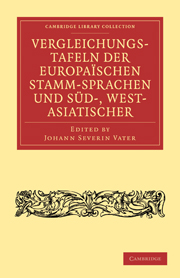Book contents
- Frontmatter
- Vorrede
- Anmerkungen en vorstehenden Vergleichungetafeln
- Vergleichungstafeln der Declination und Conjugation der Europäischen Stammsprachen und West-, Süd-Asiatischer
- R. K. Rask über die thrakische Sprachelasse
- Grammatik der Albanesischen Sprache nach Fr. Mar. da Lecee
- Grusinsche oder Georgische Sprachlehre nach Maggio, Ghai und Firalow
- Galische Sprachlehre
- Anhang
R. K. Rask über die thrakische Sprachelasse
Published online by Cambridge University Press: 04 April 2011
- Frontmatter
- Vorrede
- Anmerkungen en vorstehenden Vergleichungetafeln
- Vergleichungstafeln der Declination und Conjugation der Europäischen Stammsprachen und West-, Süd-Asiatischer
- R. K. Rask über die thrakische Sprachelasse
- Grammatik der Albanesischen Sprache nach Fr. Mar. da Lecee
- Grusinsche oder Georgische Sprachlehre nach Maggio, Ghai und Firalow
- Galische Sprachlehre
- Anhang
Summary
Adelung hat im Mithridates bewiesen; dass alle die Völkerschaften, welche sich weit und breit vom Flusse Halys in Kleinasien an, gegen Norden und Westen bis nach Pannonien erstrecken (wo der german. Stamm anfing), für Einen Volksstamm zu rechnen sind, den ich nach dem Mittelpunkte: den Thrakischen, nenne. Von dieser alten Völker classe machen die Griechen einen einzelnen Theil aus. Das nördliche Italien scheint seine Bewohner aus Pannonien oder dem nachmaligen Germanien erhalten zu haben; das untere und mittlere besetzten griechische Anbauer. Auch Völker aus Gallien vom keltischen Stamme hatten Stücke vom nördlichen Italien inne, scheinen aber nur geringen Einfluss auf die Sprache gehabt zu haben. Lennep hat aus dieser selbst, ihrem Bau und Wortvorrath bewiesen, dass das Lateinische meist vom Griechischen, besonders der äolischen und dorischen Mundart aus gegangen ist. Wir können es also zu jener alten thrakischen Sprachenclasse rechnen; wovon wir das Griechische und Lateinische als zwei Stämme nehmen können und ihr Verhältniss, wie das der zwei Stämme der gothischen Sprachclasse, den nordischen und den germanischen. Von dort leitet der Gang der Untersuchung zu dem Litthauischen, als dessen Quelle das Griechische erscheint, und Vermuthung auch zum Isländischen. So dachte auch Denina.
- Type
- Chapter
- Information
- Publisher: Cambridge University PressPrint publication year: 2010First published in: 1822

